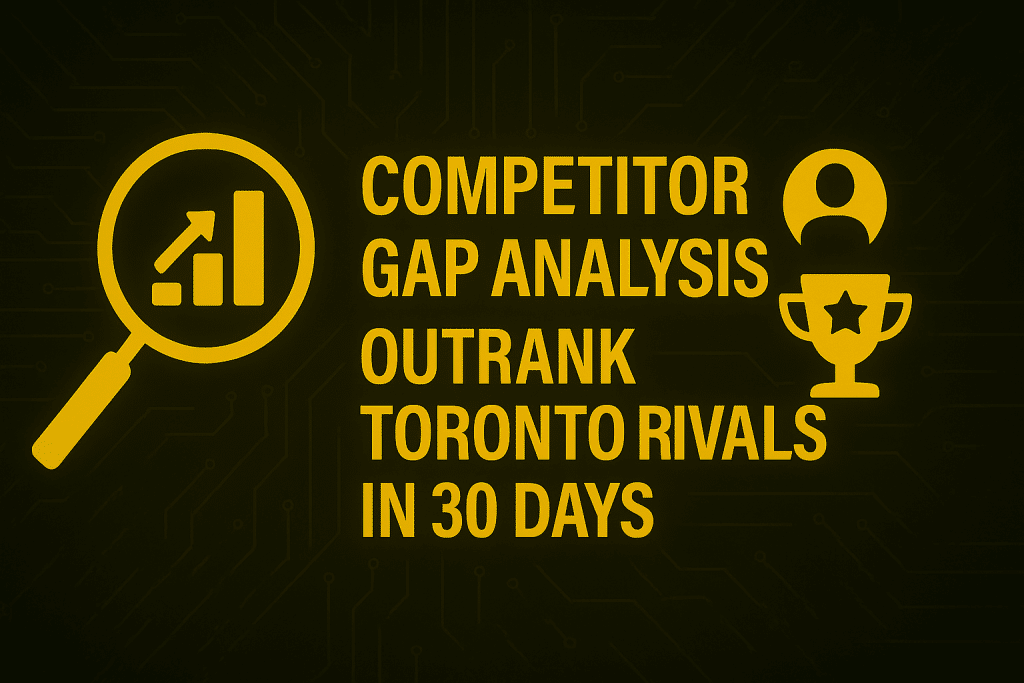In Toronto’s fiercely competitive digital landscape, businesses that fail to analyze and act on competitor data are giving away their rankings. A competitor gap analysis is not just a strategic advantage—it’s a tactical weapon to outrank rivals quickly and efficiently. This 30-day framework will help Toronto brands pinpoint SEO gaps, capitalize on missed opportunities, and build an unshakable organic presence.
Understanding Competitor Gap Analysis in SEO
Competitor gap analysis is the structured process of identifying where competitors are outperforming you in search—whether through keywords, backlinks, content strategy, or technical SEO—and then systematically closing that gap. In Toronto, where local and national players are constantly fighting for the top of Google’s search results, this analysis is essential for both established businesses and emerging brands.
Unlike general SEO audits, a gap analysis focuses outward. It answers key questions:
Which keywords are competitors ranking for that your site isn’t?
Where are they earning authoritative backlinks?
How are they structuring content to target high-intent Toronto searches?
Which pages or sections of their sites generate the most organic traction?
For a detailed overview of how leading agencies are using AI to identify these patterns, explore how top SEO agencies in Toronto are using AI to outrank the competition.
Step 1: Identify the Real SEO Competitors in Toronto
Not every business that sells the same product is your SEO competitor. Some of your biggest organic threats might be aggregators, directories, or content-heavy blogs. Use Google’s SERPs as your battlefield map.
How to Identify Your SEO Competitors
Search Core Keywords
Start with your primary service or product keywords plus “Toronto” modifiers. For example, “SEO services Toronto,” “Toronto personal injury lawyer,” or “plumbing company Toronto.”Evaluate Top SERPs
Document the sites appearing in the top 10 results. These are your true SEO competitors, regardless of whether they are direct business rivals.Use SEO Tools
Platforms like SEMrush, Ahrefs, or Google’s own Keyword Planner can reveal keyword overlap and shared ranking visibility.
By analyzing who consistently appears on Page 1 for your target searches, you’ll build a focused list of competitors to study over the next 30 days.
Step 2: Analyze Competitor Keyword Gaps
Keyword gaps are the fastest lever for rapid ranking wins. These are terms your competitors rank for—but your site doesn’t.
How to Find Keyword Gaps
Enter your domain and competitor domains into an SEO tool’s Keyword Gap or Content Gap feature.
Filter for:
Keywords with search volume above 50 in Toronto.
Keywords where competitors rank in the top 10 but your domain has no visibility.
Commercial intent keywords—these drive leads, not just traffic.
Prioritize “Easy Wins”
Focus on low-to-medium difficulty keywords with decent search volume that competitors rank for without strong authority. These can often be captured with targeted landing pages or optimized blog posts.

For a deeper understanding of keyword intent analysis in the Toronto market, review this comprehensive resource on Toronto keyword research and intent.
Step 3: Reverse Engineer Competitor Content Strategy
Toronto’s most dominant SEO players don’t publish randomly. They build content silos that target search intent at every stage of the customer journey.
Content Gap Tactics
Map competitor content by funnel stage: informational blogs, comparison pages, service pages, case studies.
Identify topics and formats they cover extensively, but you don’t. For example, if a rival has 10 posts about “local SEO for Toronto businesses” and you have none, that’s a content gap.
Siloing and Internal Linking
Competitors often structure their content into silos—clusters of interlinked pages around a central topic—to boost topical authority. You can learn more about this structure in Content Silos Toronto, which details how smart internal architecture lifts rankings.
Action Step
Create a content roadmap for the next 30 days:
3–4 targeted blog posts to fill informational gaps.
1 optimized service page targeting a competitor keyword.
Internal linking strategy to connect all related pages.
Step 4: Audit Competitor Backlinks
Backlinks remain one of the strongest ranking factors. Competitors’ backlink profiles are blueprints of their growth strategies.
Backlink Gap Analysis
Use a backlink gap tool to find unique referring domains linking to competitors but not to you.
Filter for:
Local Toronto citations (e.g., directories, industry portals).
Industry-specific publications.
Guest posting opportunities.
This process often uncovers valuable local citation sources. Why citation building still matters for Toronto local rankings in 2025 explains how consistent NAP and local links influence Google’s local pack rankings.
For authoritative, high-quality backlink strategies, the Government of Canada’s business directories and industry-specific resources like Ontario.ca business services are excellent starting points.
Step 5: Benchmark Technical SEO Factors
Technical excellence is often where Toronto businesses falter. Even with great content and backlinks, slow sites, poor structure, and crawl errors hold rankings back.
Key Areas to Benchmark
Core Web Vitals: Speed, responsiveness, visual stability.
Mobile Usability: Google prioritizes mobile-first indexing.
Crawlability & Indexation: Ensure pages are being crawled and indexed efficiently.
Internal Linking: Ensure PageRank flows to important pages.
For an actionable audit checklist tailored for Toronto businesses, refer to Toronto SEO Audit Checklist.
Step 6: Build a 30-Day Competitor Gap Action Plan
With insights collected, build a clear, day-by-day execution plan. This ensures that your team moves from analysis to implementation without delay.
Sample 30-Day Timeline
| Day | Focus Area | Key Actions |
|---|---|---|
| 1–5 | Keyword Gaps | Identify and prioritize target keywords. Create optimized content briefs. |
| 6–10 | Content Strategy | Draft and publish blog posts targeting gaps. Implement internal linking. |
| 11–15 | Backlinks | Reach out to directories, submit to citations, pitch guest posts. |
| 16–20 | Technical SEO | Fix Core Web Vitals issues, improve mobile performance, enhance site structure. |
| 21–25 | Content Siloing | Interlink new pages strategically, boost topic clusters. |
| 26–30 | Monitoring | Track rankings, traffic, and conversions. Adjust as needed. |
For inspiration, see how one Toronto business tripled organic leads in just 90 days through structured SEO execution.
Step 7: Track Progress and Iterate
Competitor gap analysis isn’t a one-time exercise. Toronto’s SEO landscape evolves rapidly. Monitor your keyword rankings, traffic growth, and backlink acquisitions weekly.
Use Google Search Console, analytics platforms, and local SERP trackers to measure progress. For deeper insights, check out how to track SEO performance with analytics.
Step 8: Combine SEO with Strategic Branding
While outranking competitors is crucial, the most dominant Toronto brands combine technical SEO with personal branding. Building thought leadership through content, media coverage, and brand search can lock in long-term ranking stability. Explore why building a personal brand in search is the next big move for Toronto founders.
Conclusion
Competitor gap analysis gives Toronto businesses a precise roadmap to identify opportunities, eliminate weaknesses, and surpass rivals—often in under 30 days. By focusing on keyword gaps, content silos, backlinks, and technical improvements, you position your brand to climb SERPs swiftly and sustainably.
For tailored SEO strategies to outrank competitors and dominate Toronto search, contact Toronto SEO experts today.


